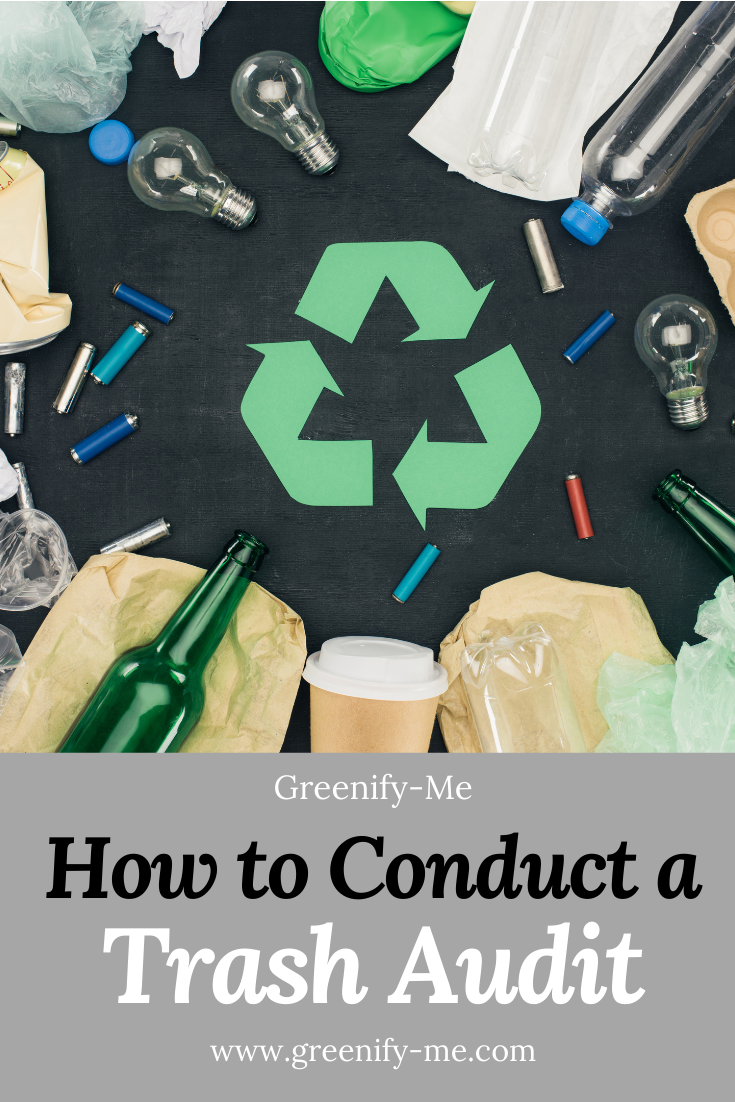When you first go zero waste, one of the best things you can do is a trash audit. It’s good to get to know your trash so you can figure out the types of waste you’re creating. For example, when I first started my waste-free journey, I noticed I was creating a lot of food packaging waste, along with food scrap waste. With the knowledge of where most of my waste was coming from, I was able to efficiently reduce it. It’s also a great way to know if you’re sorting your waste properly or not. Believe it or not, it can be very easy to contaminate your bins by improperly sorting them. Here’s how to conduct a trash audit.
This post contains some affiliate links. This means if you choose to purchase one of these items I will make a very small commission at no extra charge to you. Please see my disclosure policy for more information.
How to Conduct a Trash Audit

What is a trash audit?
A trash audit is when you collect all your trash, both recyclable and compostable, for a certain duration of time to analyze the waste you’re creating at home.
It’s very common for zero waste beginners to start their journey with a trash audit. That’s because the purpose of the activity is to help see where you can improve and reduce your trash.
Knowing your enemy (aka trash) is essential after all – and this is war. Battle analogies aside, trash audits are pretty simple and straightforward.
Step 1: Gather the essentials
To get started, grab a notebook (I love these pretty compostable notebooks) or a clipboard and your trash can. Set aside a few minutes of your time. You might want to even grab gloves if you’re not sure what lies beyond yonder trash can.
Step 2: Analyze your trash
Dump all your trash out. Review everything you find and make a note of it in your notebook, being sure to record each and every item down. Put a tally next to items you have more than one of. Or, if it’s simpler, just count it up and write down the number for each.
Here’s a mockup for you:

This is just an example of what your trash audit might look like. But you get the general gist of it.
Observe the items you tally up with the highest markings. Which items are you finding the most in your trash can? These are the trash items you should tackle first.
Step 3: Make improvements
Now that you’ve gone through your trash, you know which are the biggest offenders. You can now focus on eliminating those from your life.
It’s always best to start eliminating what you’re throwing away the most because you’ll make the most impact and see a noticeable difference, which is gratifying.
For example, based on the mockup I’ve made, the trash found the most was snack packets. To begin reducing waste with that, you could start by creating your own snacks at home (granola is easy to make), or focusing on healthier, package-free snacks (like your favorite fruits). You could also visit your own local bulk food shop to see if they sell any snacks in bulk – mine sells chocolate covered pretzels, jelly beans, granola, etc.
Take a moment to think constructively and creatively about ways to cut back on the waste your family is making the most of. I have tons of resources that can help you too:
- The Ultimate Guide to Apartment Composting is a great place to start learning about composting your food scraps (which was a huge waste factor for me as well).
- How to Have a Paperless Kitchen is a great way to reduce paper waste in your home (napkins and paper towels really add up).
- Zero Waste Snacks: 33 Plastic-Free Snacks is a great resource for healthy low waste snacks.
- How to Create a Zero Waste To Go Kit will help you avoid disposable coffee cups, plastic straws and plastic water bottles.
Please be mindful that going zero waste takes time – it won’t happen overnight. So please don’t beat yourself up if you all your trash doesn’t go away instantly. You’re always going to create some amount of trash – it’s unavoidable because we live in a linear economy, not a circular one. What matters is doing your best to reduce your waste.
For further improvements, see these beginner-friendly posts:
- 60 Easy Zero Waste Tips For Beginners
- Zero Waste Beginners Guide: 20 Tips to Get Started
- The 5 R’s of Zero Waste
Step 4: Repeat
After you’ve taken the time to make some improvements, repeat your trash audit and see how much you’ve improved.
Don’t beat yourself up if your trash can is still full – what matters is you’re trying and doing your best. Going zero waste can take months, so be kind to yourself. Honestly, I still have a few items from my pre-zero waste days myself (and I went zero waste in 2017)!
Also, when it comes to certain things, it’s okay to make a little waste. Especially when it comes to your health – that always comes first. So don’t fret over pill bottles and medication – if you need it, there’s nothing more to say. Things like that are kind of out of your control: Just make improvements where you can.

Will you conduct a trash audit anytime soon? Let me know in the comments below!
For more zero waste beginners tips, check out The 5 R’s of Zero Waste.
If you enjoyed this post, be sure to share it! If you like my content, sign up for my newsletter to get notified every time I write a new blog post. To support me even further, please consider buying me a cup of tea to help support my blog.

